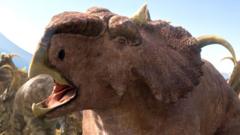At Pipestone Creek, dubbed the "River of Death," researchers are excavating a significant dinosaur bone bed, seeking to uncover the catastrophic event that led to the demise of a massive herd of Pachyrhinosaurus. As they work to unearth fossils and analyze the site, evidence suggests a devastating flash flood may have contributed to their death, allowing scientists to piece together a snapshot of this ancient ecosystem.
Unearthing the Secrets of a Dinosaur Mass Grave at Alberta's 'River of Death'

Unearthing the Secrets of a Dinosaur Mass Grave at Alberta's 'River of Death'
Scientists delve into a remarkable prehistoric graveyard in Alberta, uncovering the mystery of how thousands of Pachyrhinosaurus perished 72 million years ago.
Hidden deep in Alberta’s lush forests lies a vast graveyard, a site where thousands of dinosaurs met their end in an instant, sparking intrigue among palaeontologists. This remarkable site at Pipestone Creek, infamously dubbed the "River of Death," serves as a focal point for scientific exploration as researchers strive to resolve a 72-million-year-old puzzle: how did these dinosaurs perish?
The excavation process begins with the vigorous strike of a sledgehammer, needed to break through the dense rock layer encasing what Professor Emily Bamforth terms "palaeo gold." As her team carefully removes dirt and debris, an assemblage of fossilized bones emerges, revealing the remnants of a creature known as Pachyrhinosaurus. "That big blob of bone right there is, we think, part of a hip,” says Prof Bamforth, noting the various bones' delicate nature as they excavate.
Thousands of fossils have been retrieved from the plot, continuously yielding new discoveries. The Pachyrhinosaurus, a relative of the Triceratops, thrived during the Late Cretaceous period. These sizeable animals, averaging five meters in length and two tonnes in weight, were characterized by their prominent bony frill and horns, with a distinguishing nasal bump called a boss.
With excavation underway, the team aims to uncover the vast bed of bones that stretches for a kilometer into the hillsides of Alberta. "It's jaw-dropping in terms of its density," remarks Prof Bamforth, estimating up to 300 bones per square meter. This site may represent one of the largest known dinosaur bone beds in North America, providing insights into a significant population of Pachyrhinosaurus.
Further analysis reveals that the dinosaurs likely migrated in colossal herds from the southern regions during the winter months to the greener northern lands as summer approached. The environment of the time, believed to be much warmer than today, would have supported ample vegetation for these herbivorous giants.
But the Pipestone Creek site is not the only source of significant findings. Just a couple of hours away in the Deadfall Hills, researchers discover massive dinosaur bones along the riverbanks, awaiting collection. Notably, palaeontologist Jackson Sweder finds remains of Edmontosaurus—a duck-billed herbivore that may have grown up to 30 feet long. His work at the nearby Philip J Currie Dinosaur Museum involves analyzing these giant relics, uncovering histories intertwined in this prehistoric landscape.
As excavation continues, the vital question remains: what caused the mass death of the Pachyrhinosaurus at Pipestone Creek? Current evidence points to a catastrophic event, likely a flash flood triggered by a major storm. This natural disaster would have created an unstoppable torrent that swept through the herd, uprooting trees and dislodging rocks. Prof Bamforth explains that the Pachyrhinosaurus, due to their size and slow movement, would have found it nearly impossible to escape the event.
The geologic features found at the site show swirling sediment patterns that capture the chaos of that day, providing a snapshot of destruction forever frozen in stone. Despite the tragic fate of this herd, the work being done now continues to shed light on the mysteries of an ancient ecosystem.
Every visit holds promise, according to Prof Bamforth. "We know, every time we come here, it’s 100% guaranteed we’ll find bones. And every year we discover something new about the species." The continuous excavation efforts bring researchers closer to revealing the many secrets still hidden within Pipestone Creek.
The anticipated BBC series “Walking With Dinosaurs” promises to bring this ancient world to life, with the premiere set for May 25. As the palaeontologists continue their work, the layers of history awaiting discovery ensure the wonder of the ancient world remains ever intriguing.


















